About halfway through our stay here in Guate, we had to make a trip up to Mexico to renew our visas. And so we embarked on our international trip, and we did so just in time for International women's day. Our fearless leader... er.. program director had arranged for us to observe a march/protest of indigenous women. We were observing because we weren't legally allowed to participate, but observing involved walking along behind the people participating. The march was not only to honor International Women's Day, but also to commemorate a massacre of 40 people from an indigenous town in the area. A tale that is all too common, not just in Mexico, but in Guatemala as well, where several similar marches took place on that same day.
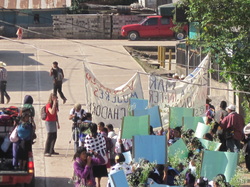 We had originally been told that the march would be only 1 hour long, and since the day had started out pretty cool and cloudy, many of us failed to bring sun screen and sufficient water. Four and half hours and 10 kilometers later, we finally finished "observing" the march. Alas, this is one of the lessons we have painfully learned here in Central America: when someone tells you that a hike is going to take about two hours, multiply that by at least two, if not three or four. Despite the fuzzy scheduling, we all fared pretty well. Considering that many of the indigenous women were marching in their full trajes, which included a heavy fur-type skirt, and frequently were walking without shoes while also carrying babies or small , we had it easy!
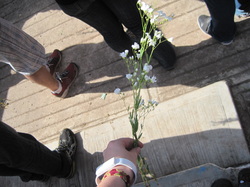 White flowers handed out to everyone at the march The women passed out a list of Consignas or statements which they then shouted the entire time during the march. Below I've translated just a few of the statements: As women...
- we have bravery to defend our town
- we want peace, justice, and dignity
- we are not slaves
- we give respect to the women of Chiapas and the world.
Aside from the obviously less than ideal physical circumstances in which these women marched, what actually impressed me more was the male presence at the march. In the U.S., if we had a march like this, I'd be surprised to see more than a handful of men coming to lend their voices to the cry for gender equality. There in Chiapas almost half of those marching were male. The male elders and other men marched along with the women, or facilitated the march by directing traffic around it and over all were very clearly there to support, but at the same time the march was clearly led by and for the women. It was very awesome and heartening to see this level of support in a society which has been known for it's machista (sexist) attitudes. All in all, I was glad that we got to observe International Women's Day in such a unique and empowering way.
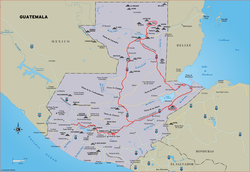 We embarked on our long excursion quite a while ago (I'm not telling you exactly when or you'll make fun of me). This was an 11 day trip around Guatemala for ostensibly "academic" purposes, okay there was some academics, but it was mostly just experiencing Guatemala in its many forms. The map to the left illustrates our path around Guate. Even though the entire country is actually smaller than Minnesota, it takes about four of five times as long to get anywhere here because of all the mountains, not to mention the sometimes superfluous amount of speed bumps. So, remember that this map includes at least two 8 hour drives, as well as several 4-5 hour drives in between.
We started out our trip from Xela and spent the first night in Guatemala City. There we met with two different organizations, one was a human rights group that has been working for many years, even during the armed conflict, to recover knowledge about los desaparecidos. Los desaparecidos are the people who were "disappeared," and typically they remain missing or were later found dead. The second group we met with was a worker's rights group, this one was particularly interesting, given the almost complete ban on worker's rights organizations during the armed conflict. They had quite the leftist lean to them, to say the least.
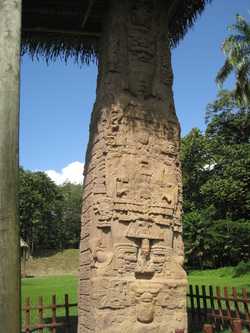 The second day was mostly driving, but we stopped off to take in some quaint ancient Mayan ruins in Quiriguá. These ruins are quite different than most people think of when they think Mayan ruins. First of all, there are no huge temples, as Quiriguá wasn't so much a large city as it was more of a conjunction for trade-routes and a point of transit between the intermediate indigenous population in Copán (in Honduras) and the Maya located in what is now Guatemala. The principle trade route for jade went through Quiriguá, at one point in time, so it was moderately important in the Mayan society of its time.The architecture of Quiriguá is not actually all that much to speak of, however, the monuments are quite impressive. The monuments, called stela, are all quite intricately carved. The stela in the picture is also the one of the largest monumental sculpture erected in the New World. In fact, at one point in time it had fallen over, probably due to a lot of rain and possibly earthquakes. The statue was unbroken, but when they tried to raise it with a winch and cables, it broke. So, in my mind, that leaves the question, how did the Mayas do it? I'll be pondering that one for a while.
 At some point in time the, United Fruit Company (see the root of all fruit evil) had acquired the land around Quiriguá, and so literally all of the surrounding land was turned into banana plantation. For some eye opening reads about the origin of your fruit as well as U.S. influence in other countries, I'd recommend The Fish That Ate the Whale, and Bitter Fruit. After a while of driving through miles and miles of banana trees, we began to see semi-truck after semi marked with Dole, Chiquita, and Del Monte, United Fruit company might not be its name anymore, but it's still going strong in Central America. Shortly thereafter we arrived in Puerto Barrios, the port that was essentially built so that the fruit companies could export, mostly to the U.S.. It was quite impressive to see all of the shipping containers packed sometimes four or five high marked with Dole and the other companies. The world certainly has a banana addiction. Our hotel that night was none other than the Hotel del Norte, the hotel from where the banana barons had reigned during the heydays of the Banana Republics. The hotel is made out of wood, which is actually quite rare in Guate, and it's easy to see why. Most of the floors had at least some slant to them, if not some extreme slants. Nevertheless, it was actually quite easy to imagine the banana barons and their families holding sway in that once (somewhat) stately place.
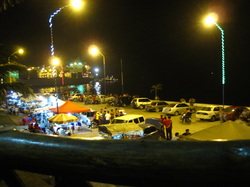 While the hotel itself was interesting, what got my attention was what was happening right outside, honestly, it was hard not to notice it with all of the music emanating from every trunk of every car parked out there. This is the malecón or seawall of Puerto Barrios and everything about it reminded me of the descriptions I've heard and read about THE Malecón in Havana, Cuba. That is to say, it is THE nighttime hang out for young Puerto Barrianos. I certainly enjoyed watching, and sometimes dancing with, the lively night life from up on the hotel balcony! With all of the merengue, salsa, and bachata ringing out, I was feeling quite like I'd arrived in a tropical dream. I have to admit to falling in love with the Caribbean coast of Guate right then and there. If, in the future, you find me on some Spanish speaking Caribbean island, this is where that particular love affair started. The next day, we found ourselves tramping around a rain forest/preserve area, which was quite fun. I particularly enjoyed sitting next to some of the waterfalls and writing in my journal. After that, we went back to Puerto Barrios to catch a "ferry" over to Livingston, which can only be reached by boat. This is how I know that I'm a lake girl, the boat ride, on the open ocean, was easily one of the highlights of this trip. I swear, I didn't stop grinning the whole ride. Below is one of the videos I took from the lancha, you can get a bit of an idea of how bumpy it was.
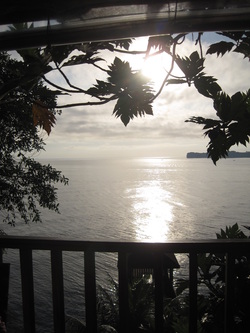 We spent that night in Livingston. A little isolated community that can only be reached by boat. It was a nice relaxing day and I was able to take many lovely photos, and even watch two iguanas duke it out in the tree next to the hotel. All in all, beautiful and worth the time to take a day to relax.
After Livingston we headed up Rio Dulce for a little "hotel" called Finca Tatin. There, my inner hippy was quite content. Tatin is kind of like an eco resort(ish), they run on solar power in the evening and there is any number of eco-adventures to take part in. The entire study abroad group decided to go kayaking through a biotope. Yet another sign that I'm a lake girl, kayaking was definitely a highlight. Somewhat less enjoyable was paddling passed a log sticking out of the river and realizing only after the fact that there was a tarantula only four or five inches from my face. EEK! Luckily it didn't move, and I held it together enough to not scream... The rest of the time in the kayaks was a pure delight, and has me making plans to go canoeing in the Northland of Wisco as much as possible this summer. You can take the girl away from the lake, but you can't take the lake away from the girl, apparently.
From Finca Tatin we headed up Rio Dulce on our way to Tikal.
Arguably the most popular, and definitely the largest Mayan ruins in Guatemala. Tikal was once the center of Mayan life as one of the most powerful kingdoms during the Classic Period. Not only did we get excessive amounts of photos of all of the temples and ruins, but we were also able to see a lot of wildlife, including monos (monkeys), pavos (turkeys), and coatis (a type of aardvark). It was a magnificent end to a long trip, I have to say. Be sure to check out all of the pictures in the photo tab to see some of these adventures in visual format!
 A few weeks ago we visited Antigua Guatemala (yeah I know, I'm super behind on updating). Antigua was the third capital city of Guatemala before it was mostly destroyed by an earthquake. The picture to the right is of the only usable portion of what is left of the Cathedral of Antigua, destroyed in the earthquake of 1717. Because of the earthquake, there are plenty of ruins to admire in Antigua. So, naturally, we commenced to explore them! Below are pictures of the ruins of the Cathedral. It was fairly awe inspiring to see the horrific destruction still evident after three hundred years. There was a lot to see, to be sure.
I didn't actually know too much about Antigua before I visited (what a bad tourist I am!). However, as I was wandering around the ruins of the Cathedral, I noticed this charming little detail:
It's a shell, of course! But not just any shell. The reason it caught my eye is because it's a shell of St. James, and I recognized it because I used to walk past shells like it every day when I studied in Spain, where I lived on one of the cities along the Camino de Santiago (The Way/pilgrimage of St. James). On The Way, pilgrims are guided by these shells, sometimes carved into buildings, like the one above, or frequently by brass cast shells laid into pavement or attached to buildings. This got me thinking: why would a marker of the Camino be here in Antigua all the way across the Atlantic? So, I snapped a quick photo of it to remind me to investigate further when I got back to my computer.
Then, as I was wandering through the ruins of the monasteries (also located in Antigua) and reading many of the plaques located therein, some of the plaques seemed to indicate that Antigua Guatemala had originally been named something else, curiouser and curiouser! Could this be related to the shell of St. James which I spied in the Cathedral? With my interest peaked, I resolved to find out.
Sure enough, Antigua was originally founded on July 25th, in 1524, St. James day. So naturally, the ever faithful (or at least apparently faithful) Spaniards named it Ciudad de Santiago de los Caballeros de Goathemalan, the City of Saint James of the Knights of Guatemala. And so named, St. James also was the patron saint of the new city. Relevant side note: the the Spaniards were not the first to establish a town in this area, the Kakchikel-Maya were settled there first, and then the Spaniards moved in and renamed it. Twas ever thus in the history of power and oppression, conquistadores de la cabeza a los pies.
So there you have it, a little bit of an unexpected and roundabout history lesson
❝Language is the road map of a culture. It tells you where its people come from and where they are going.❞
~Rita Mae Brown 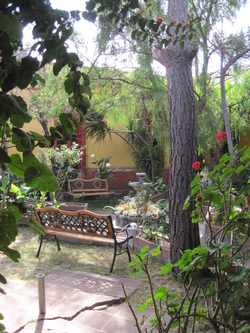 For the past three weeks (and for the next three months, too), I've had the pleasure of spending at least 5 hours a day in this beautiful place learning Spanish. It's certainly easier to go to an 8:00 A.M. class when you're greeted by smiling faces, cups of coffee, and sheer beauty in the courtyard. I swear, there's a geranium there that is taller than me (no, really, it can happen!). Between the beauty of the school, the people, and the wonderful time to mingle with maestras and other students during la pausa (the break), my first three weeks here have been a joy. My maestra for the first three weeks is named Monica (tomorrow I will have a new maestra - sniffle). We had quite a lot of fun together, I must say. So much fun, in fact, that a few other students actually commented about it to me (whoops). For instance, we watched this one day in class, and then sat there giggling for at least 5 minutes. :D In addition to spending plenty of time on grammar (5 hours of Spanish a day is a LOT!), we spend quite a lot of time just having conversations. Monica and I have talked about history, poverty and other forms of social injustice, abortion, and the civil war in Guatemala to name just a few topics. One of my favorite topics so far? Rigoberta Menchú. Feminist that I am, it figures that I would like a strong, female, peace activist. The Wikipedia page linked above doesn't necessarily have the most complete information, but it gives you some idea. La vida interesante!
"Buen provecho loc. col. Expresión de cortesía para mostrar el deseo de que una cosa resulte útil o conveniente para la salud o el bienestar de alguien,especialmente la comida" 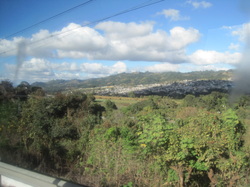 View of Guatemala City from a distance. I'm almost to the end of my second week here in Guatemala, and it sure has been difficult to have time to update the blog!
My flights to Guate were uneventful, which was nice, and I was able to get through Customs and Immigration in Guatemala City without any problems and without losing my bags. In my book, that's an awesome ride!
Once I made it to the outside of the airport, it was slightly crazy. most people were shouting at me "Antigua $10," and it took me a moment to find the others in my group in the huge crowd that was waiting. Once we were all assembled, Our director called up our bus, and we were on our way to Xela!
 Guatemalan Countryside It's hard to describe how terrifying it is being a passenger on the highways of Guate. Think riding in the front of an Irish bus, but on the side of a mountain, and with the traffic rules of India (a.k.a. none to speak of). It was like living through an episode of "Most Dangerous Roads." This picture looks so tranquil, but we were speeding along so fast, it was actually very hard to get a picture to turn out nicely. The speed, uncertainly, and sometimes outright danger combined with the altitudes made the ride quite exhausting. Not to mention the smell of burning garbage, which is quite pervasive in the countryside because frequently los campesinos don't really have much wood to burn, so they burn their garbage. It's hard to describe the images of extreme poverty that are so apparent here in Guate, we definitely live in a privileged existence in the U.S.
About 4 hours after leaving the airport, we were finally arriving in Xela with a police escort (because, you know, police escorts aren't conspicuous at all...), and we got our bus stuck. Yup, stuck. In the street. Between a car and a pole. My favorite was the Guatemalan ingenuity that got us unstuck: gather 20 or so random men from the street (as well as the six Johnnies we have with us on the trip) to physically pick up the car and move it. Memorable, to say the least! After that we were able to make it to the language school without any more problems and meet all of our host families.
I'm living with a younger family. I have a host mother (of course!), an abuela (grandmother) and a host brother and sister who are 14 and 4, respectively. So far, I've really enjoyed living with them, It's quite amazing how four year olds can make games out of almost anything - yesterday we (my host sister and I) spent twenty minutes walking/running back and forth down the hallway. It was, apparently, hysterical. Ah! La vida guatemalteca!
"Yo vengo de todas partes,
Y hacia todas partes voy:
Arte soy entre las artes,
En los montes, monte soy."
~ Jose Martí Jose Martí was a Cuban poet, but it really is an appropriate quote for the moment... "I am art among arts, in the mountains I am a mountain."* Fitting for a high altitude destination, right?
After a semester of preparation, including several group meetings, a paper, a research proposal, reading guidebooks, and lots of $$, I'm about to head off for four months in Guatemala. My destination is Quetzaltenango, or Xela as it's known to the locals. I'll be living with a host family and taking intensive Spanish classes, as well as a theater course and a Guatemalan history course.
Until recently, with the exception of the money, all of these preparations have seemed somewhat abstract. Then came the part about packing. Amusingly, the packing list reflected a side of Guatemala that was downplayed during the application process...
Packing List:
"Pepto for the days you’re a lil’ loose. Imodium for when you can hardly hold it in! Only take Imodium when it is absolutely necessary, you’ll be backed up for days!" Ehuh, that's right - written between those lines is the implication "you will most likely be sick!" at one point on the list they recommend packing an extra pair of underwear when you go out - admittedly wise. I confess that I'd thought of this before, but the sheer quantity of pharmaceutical type products suggested for packing kind of floored me. Take a look...
 Yup, that takes up about a third of my pack. The only luggage I'm bringing along is a 60 liter hiking backpack, and my anti-explosivepoo (and other health) products take up about a third of it, and this is sans the prescriptions, like anti-malaria pills, that are all packed in my carry-on.
Now, this is what I call an adventure! :D
Next challenge? Getting my entire life for the next 4 months to fit into one 60 liter pack and only weigh 50 lbs. Challenge Accepted!
* Translation is my own, and probably quite crappy!
|







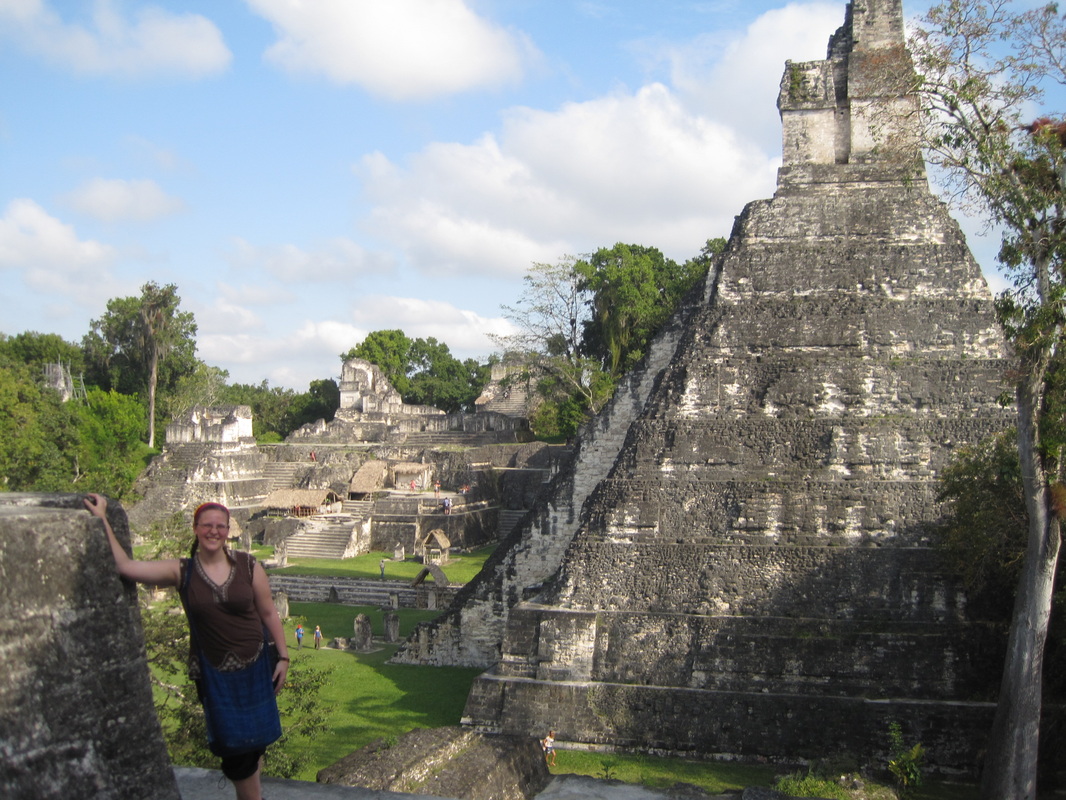







 RSS Feed
RSS Feed